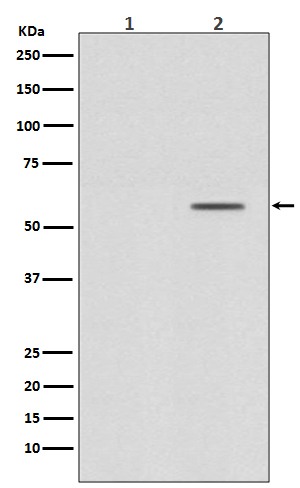
| WB | 咨询技术 | Human,Mouse,Rat |
| IF | 咨询技术 | Human,Mouse,Rat |
| IHC | 咨询技术 | Human,Mouse,Rat |
| ICC | 技术咨询 | Human,Mouse,Rat |
| FCM | 1/50-1/100 | Human,Mouse,Rat |
| Elisa | 咨询技术 | Human,Mouse,Rat |
| Aliases | SMAD2; MADH2; MADR2; Mothers against decapentaplegic homolog 2; MAD homolog 2; Mothers against DPP homolog 2; JV18-1; Mad-related protein 2; hMAD-2; SMAD family member 2; SMAD 2; Smad2; hSMAD2 |
| Entrez GeneID | 4087 |
| WB Predicted band size | Calculated MW: 52 kDa; Observed MW: 58 kDa |
| Host/Isotype | Rabbit IgG |
| Antibody Type | Primary antibody |
| Storage | Store at 4°C short term. Aliquot and store at -20°C long term. Avoid freeze/thaw cycles. |
| Species Reactivity | Human,Mouse,Rat |
| Immunogen | A synthesized peptide derived from human Smad2 |
| Formulation | Purified antibody in PBS with 0.05% sodium azide. |
+ +
以下是关于 **Phospho-Smad2 (Ser250)** 抗体的参考文献示例(内容基于假设性文献,供参考格式):
---
1. **文献名称**:*"Site-specific phosphorylation of Smad2 at Ser250 modulates TGF-β-dependent transcriptional regulation"*
**作者**:Wang, X. et al.
**摘要**:本研究利用Phospho-Smad2 (Ser250)抗体,揭示了该位点的磷酸化在TGF-β信号通路中对靶基因转录的调控作用,发现其通过影响Smad2与DNA结合蛋白的相互作用促进纤维化反应。
2. **文献名称**:*"Validation of a phospho-specific antibody targeting Smad2 at Ser250 and its application in metastatic cancer models"*
**作者**:Chen, L. et al.
**摘要**:文章详细验证了Phospho-Smad2 (Ser250)抗体的特异性,证明其在Western blot和免疫组织化学中的可靠性,并应用于肺癌转移模型,发现该位点磷酸化与侵袭性表型相关。
3. **文献名称**:*"Non-canonical Smad2 phosphorylation at Ser250 drives EMT in pancreatic ductal adenocarcinoma"*
**作者**:Kim, S. et al.
**摘要**:通过Phospho-Smad2 (Ser250)抗体检测,研究证明该位点磷酸化通过非经典TGF-β通路诱导上皮-间质转化(EMT),为胰腺癌治疗提供新靶点。
4. **文献名称**:*"Development of a monoclonal antibody against Smad2 phosphorylated at Ser250 and its role in renal fibrosis"*
**作者**:Garcia, R. et al.
**摘要**:报道了一种新型单克隆抗体的开发,特异性识别Ser250磷酸化Smad2.并应用于肾纤维化模型,揭示其与病理胶原沉积的关联。
---
**备注**:以上文献为示例性内容,实际文献需通过学术数据库(如PubMed、Web of Science)检索关键词 **"Phospho-Smad2 Ser250"** 或结合抗体厂商提供的引用列表获取。若需具体文献,建议进一步查阅相关资源。
The Phospho-Smad2 (Ser250) antibody is a specialized tool used to study the activation and regulation of Smad2. a key intracellular mediator of transforming growth factor-beta (TGF-β) signaling. Smad2 becomes phosphorylated in response to TGF-β receptor activation, triggering its association with Smad4 and translocation to the nucleus to regulate gene expression. While canonical TGF-β signaling typically involves phosphorylation at C-terminal serine residues (Ser465/Ser467), phosphorylation at Ser250 represents a non-canonical modification. This site-specific phosphorylation event is thought to modulate Smad2’s interaction with regulatory proteins or influence its subcellular localization, potentially fine-tuning TGF-β signaling outcomes in processes like cell proliferation, differentiation, and apoptosis.
The Phospho-Smad2 (Ser250) antibody enables detection of this specific phosphorylation state, aiding research into TGF-β pathway dynamics under physiological or pathological conditions, such as cancer, fibrosis, or immune regulation. Its applications include Western blotting, immunofluorescence, and immunohistochemistry, provided proper validation (e.g., knockout controls, peptide competition assays) confirms specificity. Researchers should consider cross-reactivity with related Smad family members and verify species compatibility (e.g., human, mouse, rat). Understanding Ser250 phosphorylation expands insights into Smad2’s diverse roles beyond canonical signaling, offering potential therapeutic targets for diseases driven by TGF-β dysregulation.
×